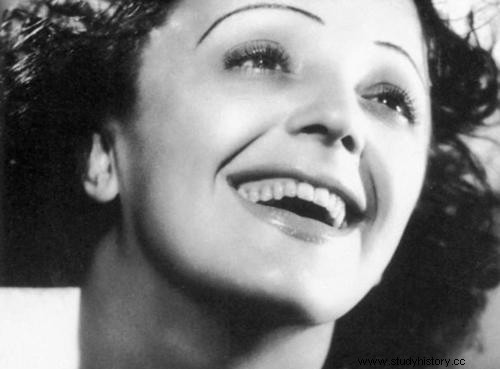Edith Giovanna Gassion , known as Edith Piaf and nicknamed "la Môme" (1915 – 1963), is the most famous French singer in France and abroad, with her countless great successes such as La Vie in pink, The Hymn to Love, The Crowd, Milord….
The brothel
 Daughter of Annetta Maillard, street singer, and Louis Alphonse Gassion, circus artist, Edith was born on December 19, 1915. His parents will have a second child three years later, Herbert. Her father having gone to the front and her mother too poor to raise her, Edith is entrusted to her maternal grandmother who completely abandons her. After eighteen months, her father, on leave, entrusted her to her paternal grandmother who ran a brothel.
Daughter of Annetta Maillard, street singer, and Louis Alphonse Gassion, circus artist, Edith was born on December 19, 1915. His parents will have a second child three years later, Herbert. Her father having gone to the front and her mother too poor to raise her, Edith is entrusted to her maternal grandmother who completely abandons her. After eighteen months, her father, on leave, entrusted her to her paternal grandmother who ran a brothel.
Edith is pampered by everyone there. At the age of seven or eight, she was temporarily blind following an illness and her grandmother went to Lisieux with the prostitutes of the brothel to pray at Thérèse's tomb. Edith recovers eight days later and will retain a special devotion to Saint Thérèse.
The Kid Piaf
 In 1922, Louis took his daughter back with him and took her to live a life of traveling artists; like her mother, Edith begins to sing in the street. In 1930, at fifteen, she left her father and sang a duet with her friend Simone Berteaut. Two years later, she moved to Montmartre with Louis Dupont, her first love; they will have a daughter, Marcelle, who will live only two years.
In 1922, Louis took his daughter back with him and took her to live a life of traveling artists; like her mother, Edith begins to sing in the street. In 1930, at fifteen, she left her father and sang a duet with her friend Simone Berteaut. Two years later, she moved to Montmartre with Louis Dupont, her first love; they will have a daughter, Marcelle, who will live only two years.
In 1935, a cabaret manager, Louis Leplée, noticed her talent and chose her as the stage name "la Môme Piaf". She was spotted by composers and musicians Raymond Asso and Marguerite Monnot, and recorded a first album in 1936. After the assassination of Louis Leplée, linked to criminal circles, Raymond Asso became her mentor, writing songs for her and taking hand his career.
Life in pink
In March 1937, Edith Piaf began her music-hall career at the A.B.C. in Paris where it met with immediate success. She embarked on theater and cinema, notably performing a play written for her by Jean Cocteau. During the Second World War, she continued to give concerts and protected Jewish artists. In 1944, while performing at the Moulin Rouge, Edith met Yves Montand, whom she fell in love with. That same year, his father died and his mother only survived him by a year.
In 1945, Edith wrote La Vie en rose , one of his first titles and a great success. She continues the theater by performing at the Comédie-Française. In 1946, she went on tour with Yves Montand then the two separated; Edith continues her tour in Northern Europe and then in the United States. In New York, she lives a great love story with the boxer Marcel Cerdan. But on October 28, 1949, Marcel dies in a plane crash, when he comes to join her, and Edith is devastated by suffering and guilt. She begins to take large doses of morphine.
Morphine addiction
Edith Piaf continues to perform, notably singing songs composed by Charles Aznavour. In September 1952, she married singer Jacques Pills. In 1953, she began a drug treatment and resumed her career in the United States, where she experienced triumph. In 1956, she divorced. In 1958, she had a serious car accident with Georges Moustaki, which worsened her state of health and her addiction to morphine. In 1959, she collapsed on stage.
Thereafter, Edith continued to give concerts but her state of health deteriorated. In 1962, she married the young singer Théo Sarapo, with whom she sang in duet.
Edith Piaf died on October 10, 1963 at 1:10 p.m. in Grasse in the Alpes-Maritimes at the age of 47. She is buried in Père Lachaise with her father, her second husband and her daughter, Marcelle. Leaving behind an impressive discography, she remains to this day the most famous French-speaking singer in France and abroad.
